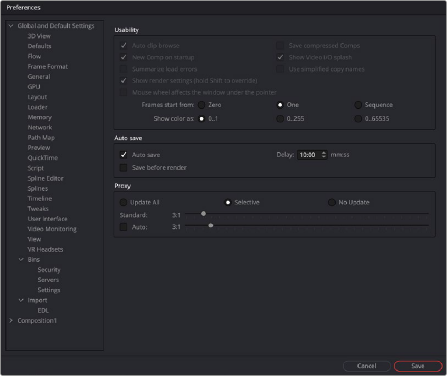
< Previous | Contents | Next >
The first entry in the Preferences sidebar is assigned to the Global preferences. Clicking the Global and Default Settings disclosure arrow reveals the following sections.

Fusion Studio Global and Default settings
![]()
3D View
The 3D View preferences offer control over various parameters of the 3D Viewers, including grids, default ambient light setup, and Stereoscopic views.
AVI (Windows Fusion Studio Only)
The AVI preferences configure the default compression options when creating AVI files from a Saver node. These settings can be overridden on a case-by-case basis using the Format tab in the Saver’s Inspector.
Defaults
The Defaults preferences are used to select default behavior for a variety of options, such as animation, global range, timecode display, and automatic tool merging.
Flow
You use the Flow preferences to set many of the same options found in the Node Editor’s contextual menu, like settings for Tile picture, the Navigator, and pipe style.
Frame Format
The Frame Format preferences are used to create new frame formats as well as select the default image height and width when adding new creator tools like Background and Text+. You also set the frame rate for playback.
General
The General preferences contain options for the general operation, such as auto save, and gamma settings for color controls.
GPU (Fusion Studio Only)
The GPU preferences include options for selecting specific GPU acceleration methods based on your computer platform and hardware capabilities. It is also used for enabling caching, and debugging GPU devices and tools.
Layout (Fusion Studio Only)
You can use the Layout preferences to save the exact layout of Fusion’s windows.
Loader (Fusion Studio Only)
Using the Loader preferences, you can set options for the default Loader’s depth and aspect ratio as well as define the local and network LoaderCache settings.
Memory (Fusion Studio Only)
Memory management for multi-frame and simultaneous branch rendering is configured in the Memory preferences.
Network (Fusion Studio Only)
![]()
The Network rendering preferences are used to configure options such as selecting a render master, email notification, and whether the machine can be used as a render slave.
Path Map
Path Map preferences are used to configure virtual file path names used by Loaders and Savers as well as the folders used by Fusion to locate comps, macros, scripts, tool settings, disk caches, and more.
Preview (Fusion Studio Only)
The Preview preferences is where you configure the Preview creation and playback options.
QuickTime (macOS Fusion Studio Only)
This section lets you preconfigure the QuickTime codec used for rendering.
Script
The Script preferences include a field for passwords used to execute scripts externally, programs to use for editing scripts, and the default Python version to use.
Spline Editor
The Spline Editor preferences allow you to set various spline options for Autosnap behavior, handles, markers, and more.
Splines
Options for the handling and smoothing of animation splines, Tracker path defaults, onion-skinning, roto assist, and more are found in the Splines preference.
Timeline
The Timeline preferences is where you create and edit Timeline/Spline filters and set default options for the Keyframes Editor.
Tweaks
The Tweaks preferences handle miscellaneous settings for modifying the behavior when loading frames over the network and queue/network rendering.
User Interface
These preferences set the appearance of the user interface window and how the Inspector is displayed.
Video Monitoring (Fusion Studio Only)
The Video Monitoring preferences is where you can configure your Blackmagic video display hardware for monitoring on an HD, Ultra HD, or DCI 4K display.
View
The View preferences are used to manage settings for viewers, including default control colors, Z-depth channel viewing ranges, default LUTs, padding for fit, zoom, and more.
![]()
VR Headsets
The VR Headsets preferences allow configuration of any connected Virtual Reality headsets, including how stereo and 3D scenes are viewed.
Bins (Fusion Studio Only)
There are three panels as part of the Bins preferences: a Security panel where you set users and passwords for serving the local bins; a Servers panel used to select which remote Bin servers are connected; and a Settings panel for stamp rendering.
Import
The Import settings contain options for EDL Import that affect how flows are built using the data from an EDL.